
LONDON TRANSPORT T CLASS
AEC Regal single-deckers
This page prepared by Ian Smith, created 13th June 1999.
Early GreenLines: T38, T51-T149, T157-T206, 207-306
T38: the prototype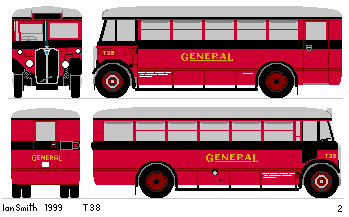 The chassis for T38 was extracted from the batch of fifty intended for buses,
and had a rather more refined body built for it,
for use on the express services
just developing in the London Area.
These had started in December 1929 using private hire coaches,
between Watford and Golders Green.
The chassis for T38 was extracted from the batch of fifty intended for buses,
and had a rather more refined body built for it,
for use on the express services
just developing in the London Area.
These had started in December 1929 using private hire coaches,
between Watford and Golders Green.
The body for T38 was rather tall, as a high floor was adopted to avoid wheel-arch intrusion and permit all seats to be forward-facing - rather different thinking from that adopted for today's buses! The short 26 ft length imposed as a stage carriage vehicle in London therefore made this a rather dumpy looking vehicle. Perhaps "dumpy" is unkind: "matronly"? 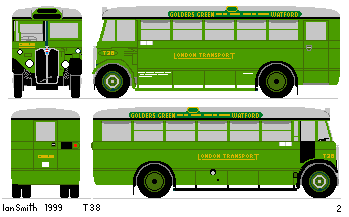 T38 had a six-bay body, with a doorway at the rear.
It had a fixed roof, a round-fronted cab,
and a single-line destination indicator above the cab.
T38 had a six-bay body, with a doorway at the rear.
It had a fixed roof, a round-fronted cab,
and a single-line destination indicator above the cab.
It entered service in March 1930, wearing the General red and black livery,
on the Watford to Golders Green service,
where it spent all its working life.
It gained a plain green livery in early London Transport days,
plus roofboards and an illuminated GreenLine sign above the front destination indicator.
Later it received two-tone green GreenLine livery.
It was withdrawn and scrapped in March 1939.
The rear-door Greenlines: T51-149, 155, 157-206These were a development of the T38 design, using seven unevenly sized bays instead of six. The rear nearside door was a two-part outward-folding type, recessed into an alcove at the top of the two entrance steps. The emergency door was moved to the offside, behind the driver. They were painted initially in General red, with a black body-band and black and red panel-lining. They wore a small "General" fleetname on the sides, and a small General roundel on the back. The number plates and lights moved down to the rear offside, with the Metropolitan stage carriage licence plate on the left.Route points were painted on the storm louvres over the windows, and also on the curved waist-band at the rear.
They were built by a number of body-builders:
Fifty each were built by Chiswick, Hall-Lewis (Park Royal) and Shorts (Rochester).
General allocated twelve, including the first (T155),
for its own new express services to Windsor, starting in April 1930.
In May eleven went to Watford to join T38,
replacing the private hire Reliances,
and five went to Slough for the London - Sunningdale service.
These 28 carried "General" fleetnames.
July 1930 saw the introduction of the "GreenLine" fleetname. The new "coaches" were used to start new services to and from Romford, Guildford, Watford, Hitchin, Harpenden, Bishops Stortford, Staines and Addlestone, while Reigate and Romford also received second allotments. All this was a strategic move by the LGOC to prepare for the forthcoming London Traffic Act. By having a strong network of express services available under the GreenLine label - a label protected against copycats by the setting up of a number of similarly-named companies - they hoped to establish the monopoly position within the capital area. As they did. The vehicles allocated to "General", "Autocar" and "East Surrey" were gathered under the "Greenline" label in the autumn of 1930, and then seven were repainted in the colours of Amerham & District and allocated there in January 1931. Greenline adopted a new green and black livery, and the still-new fleet was repainted.
The war brought a reprieve for some. Nineteen were reinstated for bus use on the outbreak of war,
and some even saw service on the re-instated Greenline services.
They were fitted up for use with snow-ploughs as required - which was relatively often in the severe winters of the early forties which defeated Hitler in Russia.
They were all withdrawn from service use again by 1942, due to the rubber shortages, but appeared with their ploughs if required.
They were sold to the Allied Control Commission for use in post-war Germany in May 1945.
T120 was converted for use as a London Transport staff ambulance during the war. For this role it acquired a door in the back. The nearside rear doorway was filled in and a doorway made in the front bay. This was fitted with double doors. After the war it exchanged this body with a front entrance coach body (from T305), and re-entered service as a bus, lasting until April 1949.
The front-entrance GreenLines T207-306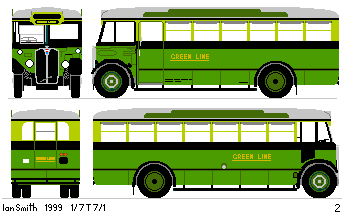 Another 100 GreenLine coaches followed on in early 1931,
to beat the March introduction of the Road Traffic Act.
These had forward entrances with internal sliding doors.
They also had a neater combination of destination blind and GreenLine advert on the front,
the latter now placed under the destination line instead of being perched above.
Roof boards were carried along the sides of the roof,
a GreenLine practice that was to survive for many years.
Another feature that was to be repeated was the central rear emergency exit.
They seated thirty within their twenty-six foot length.
Another 100 GreenLine coaches followed on in early 1931,
to beat the March introduction of the Road Traffic Act.
These had forward entrances with internal sliding doors.
They also had a neater combination of destination blind and GreenLine advert on the front,
the latter now placed under the destination line instead of being perched above.
Roof boards were carried along the sides of the roof,
a GreenLine practice that was to survive for many years.
Another feature that was to be repeated was the central rear emergency exit.
They seated thirty within their twenty-six foot length.
A new petrol engine and higher gear ratio gave them a good top speed of around 60mph. (With no speedometer fitted, this gave rise to some prosecutions in their early days!). They were classified 1/7T7/1. Restored and preserved T219 demonstrates its handsome lines at covent Garden, December 1998. It retains the widened rear door, received for wartime ambulance duties. Photos by Ian Smith.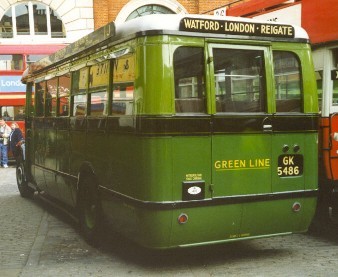 These buses too had relatively short (but hard-working) lives,
as technology improved
and style changes in vehicle design accelerated through the 1930s.
By 1938 the norm for Greenline travel had become the glorious 10T10,
and the 1/7T7/1s were looking old.
They were chosen in preference to the earlier 7T7s for rebodying and re-engining,
using slightly second-hand bodies from Reliances.
These modern-looking bodies had been built by Weymann in 1935,
and fitted to near-redundant Reliance chassis.
Perhaps someone had this swap in mind at the design stage,
for the bodies looked far better with a Regal radiator
than with the small Reliance one.
These 11T11s are dealt with in more detail later.
These buses too had relatively short (but hard-working) lives,
as technology improved
and style changes in vehicle design accelerated through the 1930s.
By 1938 the norm for Greenline travel had become the glorious 10T10,
and the 1/7T7/1s were looking old.
They were chosen in preference to the earlier 7T7s for rebodying and re-engining,
using slightly second-hand bodies from Reliances.
These modern-looking bodies had been built by Weymann in 1935,
and fitted to near-redundant Reliance chassis.
Perhaps someone had this swap in mind at the design stage,
for the bodies looked far better with a Regal radiator
than with the small Reliance one.
These 11T11s are dealt with in more detail later.
T306 was more seriously rebuilt, as trolleybus wire lubricator 422W, in March 1940,
joining similar 114W (ex T320).
This required an upper working space and greasing booms.
Livery was trolleybus red with black-edged cream bands and trolleybus logos.
It worked in this form until August 1952.
Yet others stayed on coach work until the advent of the TFs in 1939, were withdrawn, and then were used as staff ambulances during the war. In 1946 they received spare diesel engines and were put back to work as buses. They could be distinguished from the earlier batch of bus conversions by the neater arrangement of the destination box, which hung down from the canopy rather than sticking up. These too soon made their way into Central Area service, particularly helping out on the Walton Bridge routes at Kingston Some kept their glass storm louvres to the end, while others had them replaced by continuous metal strips. Several were repainted into red and white livery. They were retired (again) in 1950. But wait! Yes. One escaped again! T219 was rescued from oblivion and restored to GreenLine condition for the London Transport Museum, and may still occasionally be seen attending rallies or other functions.
|
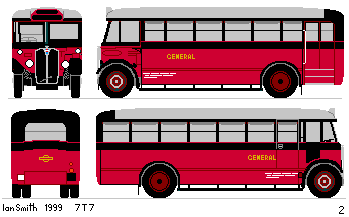
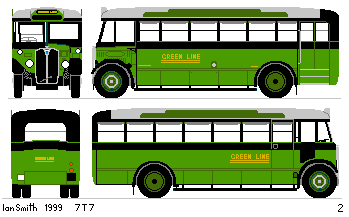 Although the rear door went out of fashion these coaches were never rebuilt
(except for T120).
They roared in and out of London every day,
accumulating significantly higher mileages than their bus contemporaries,
and were withdrawn from exhaustion when the 10T10s came on the scene in 1939.
Although the rear door went out of fashion these coaches were never rebuilt
(except for T120).
They roared in and out of London every day,
accumulating significantly higher mileages than their bus contemporaries,
and were withdrawn from exhaustion when the 10T10s came on the scene in 1939.
 Meanwhile seventeen of the withdrawn coaches were rebuilt as service vehicles:
railway breakdown tenders, full- and half-tilt lorries, dropside lorries....
In this form they saw longer use than as coaches, many lasting to the late fifties,
and a few into the sixties.
Meanwhile seventeen of the withdrawn coaches were rebuilt as service vehicles:
railway breakdown tenders, full- and half-tilt lorries, dropside lorries....
In this form they saw longer use than as coaches, many lasting to the late fifties,
and a few into the sixties.
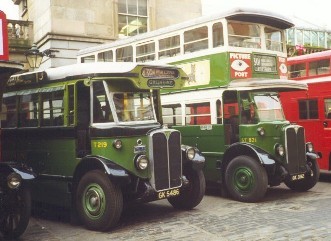
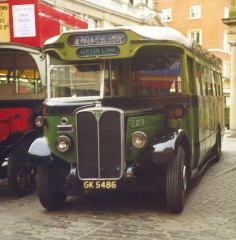
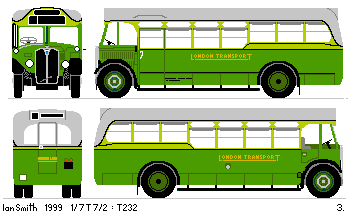 One other rebuild was T232, which suffered a severe accident in 1933.
The opportunity was taken to experiment using the chassis
which was rebodied by Weymann with an all-metal art-deco design
that looked very strange. It followed the fashion for sweeping curves,
and had the bodyside windows set at different levels,
the first four bays having small quarterlights above
the main louvred windows.
The routing points were painted on these: illuminated ad panels!
The concoction went to Reigate,
but seems not to have met with universal acclaim,
resulting in T232 too receiving a more sober 11T11 body,
while the body was fitted to an old Reliance chassis and sold.
One other rebuild was T232, which suffered a severe accident in 1933.
The opportunity was taken to experiment using the chassis
which was rebodied by Weymann with an all-metal art-deco design
that looked very strange. It followed the fashion for sweeping curves,
and had the bodyside windows set at different levels,
the first four bays having small quarterlights above
the main louvred windows.
The routing points were painted on these: illuminated ad panels!
The concoction went to Reigate,
but seems not to have met with universal acclaim,
resulting in T232 too receiving a more sober 11T11 body,
while the body was fitted to an old Reliance chassis and sold.
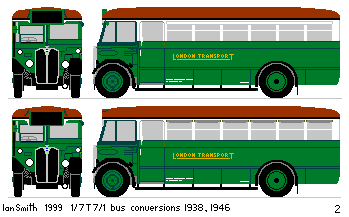 Others were demoted to bus work, retaining their T7/1 bodies,
but with a larger front route and destination indicator box
perched up on the canopy at the front.
These started in the Country Area, but many were transfered
to the Central Area during or just after the war.
During the vehicle shortages at the end of the forties
several green-liveried examples were seen penetrating
the centre on trunk route reliefs.
Others were demoted to bus work, retaining their T7/1 bodies,
but with a larger front route and destination indicator box
perched up on the canopy at the front.
These started in the Country Area, but many were transfered
to the Central Area during or just after the war.
During the vehicle shortages at the end of the forties
several green-liveried examples were seen penetrating
the centre on trunk route reliefs.
 T51-206: bus histories
T51-206: bus histories Bus Stop
Bus Stop contents
contents Generals
Generals GreenLines
GreenLines